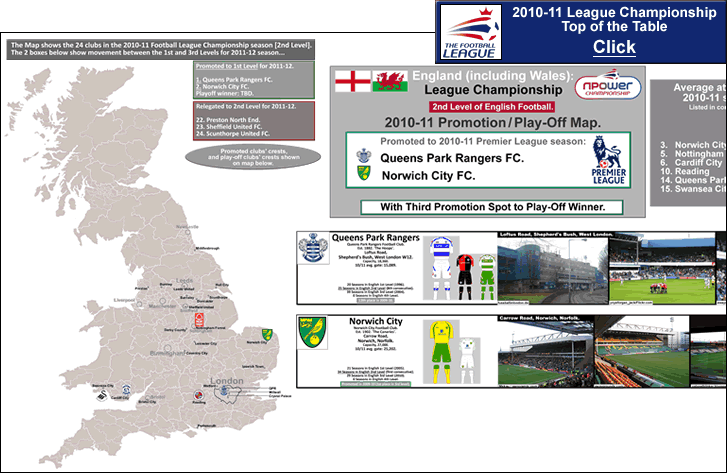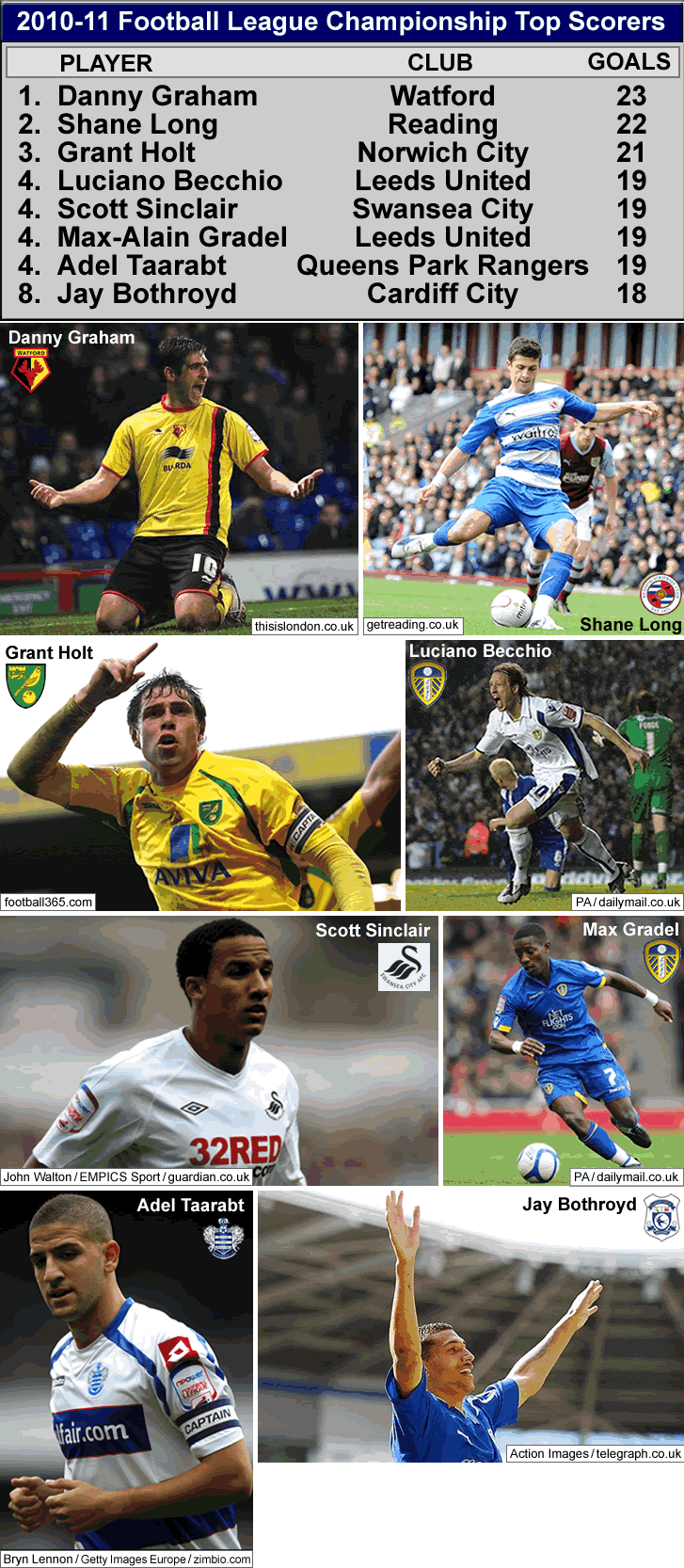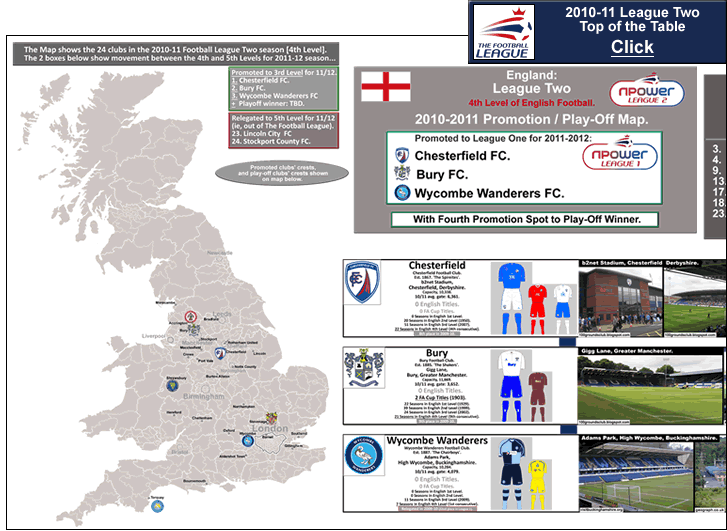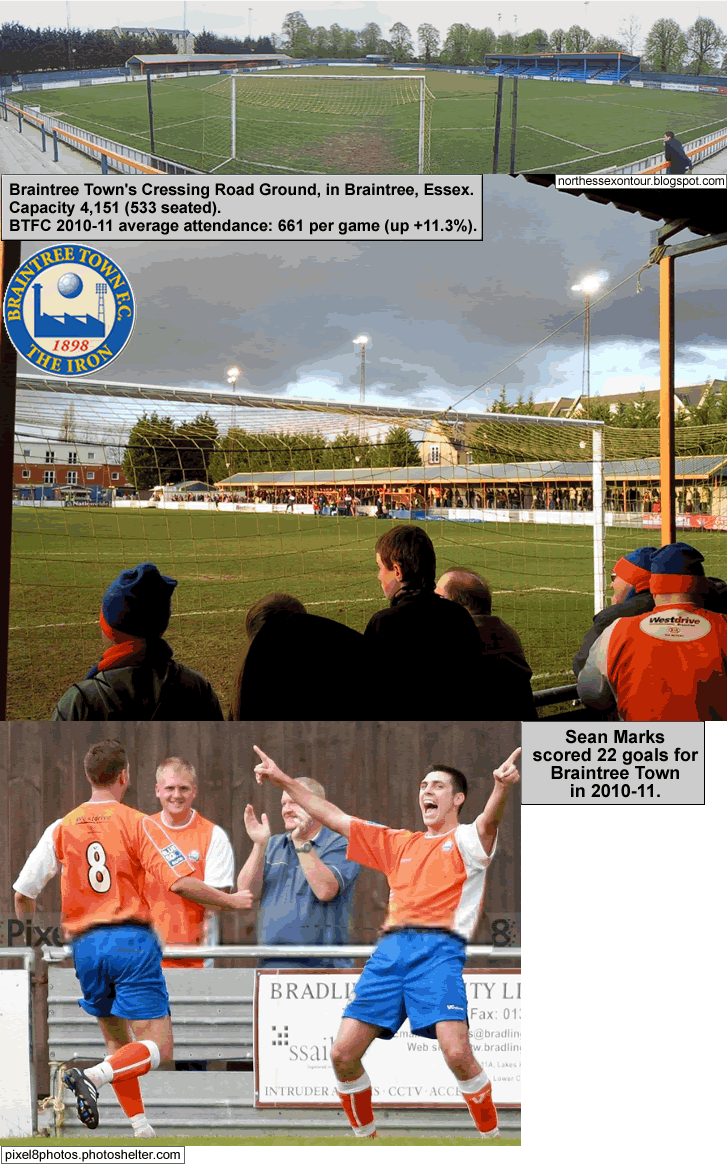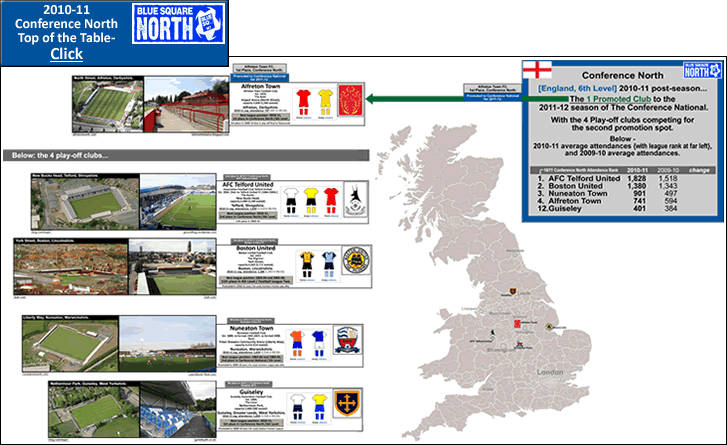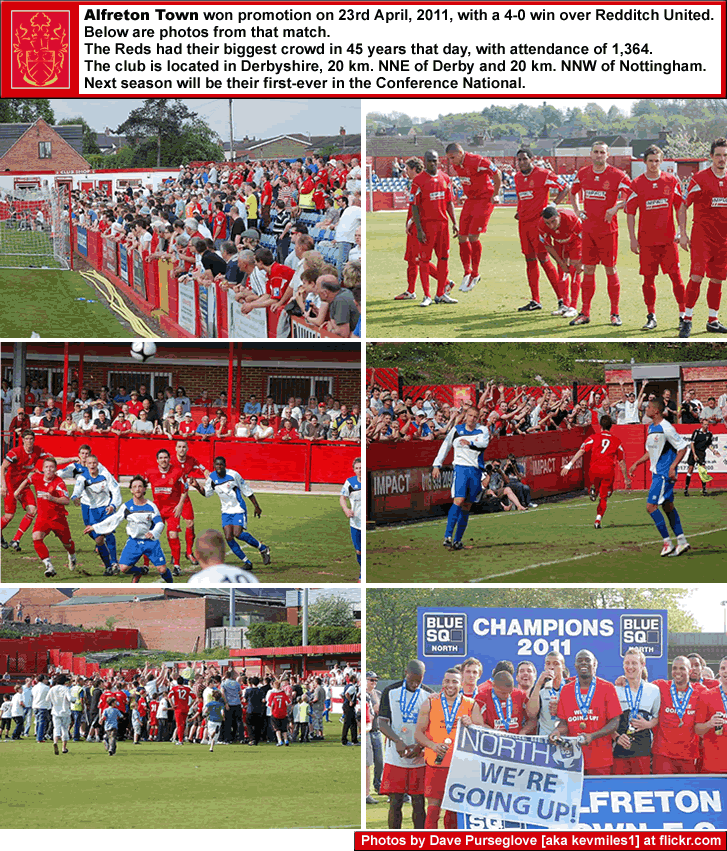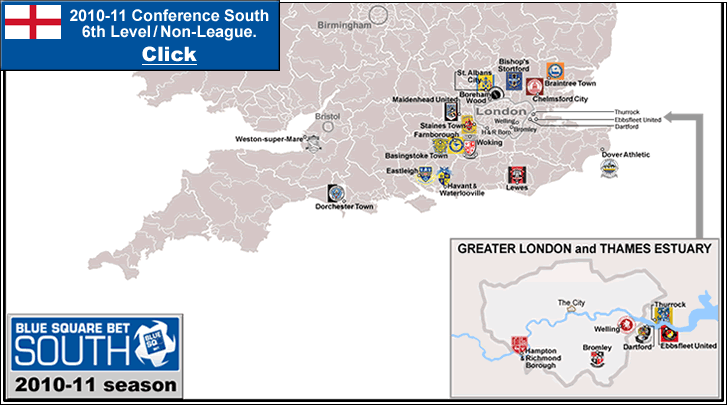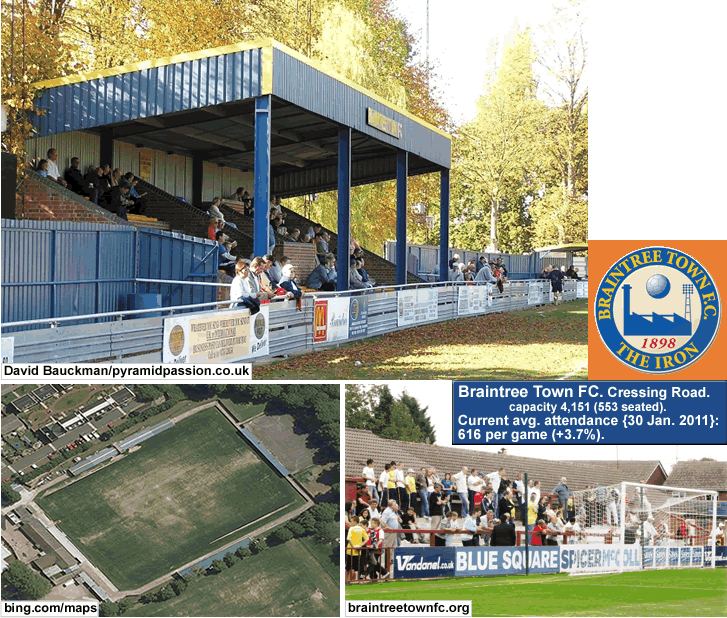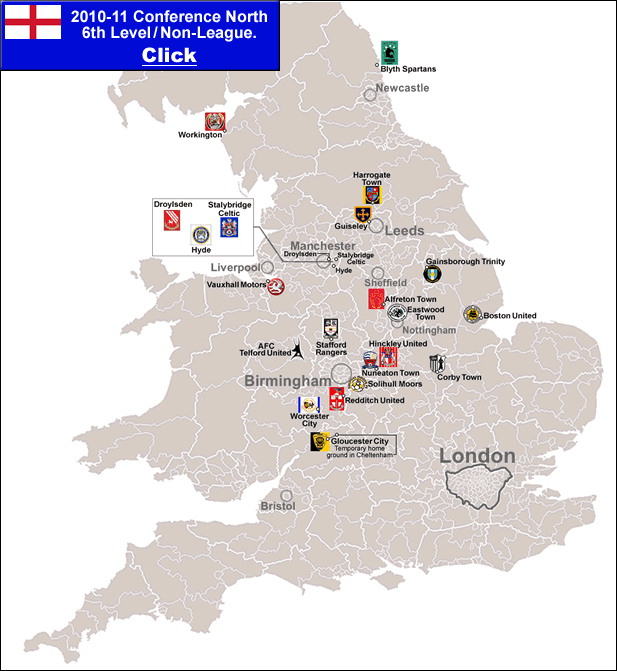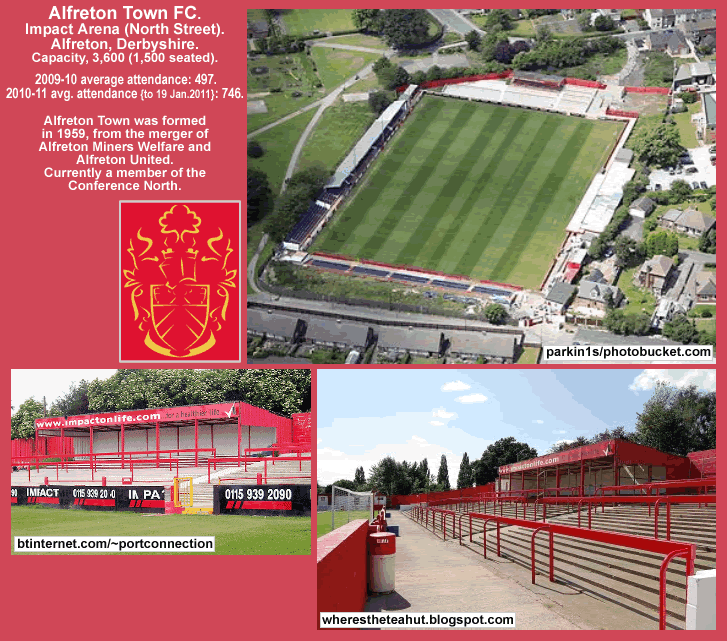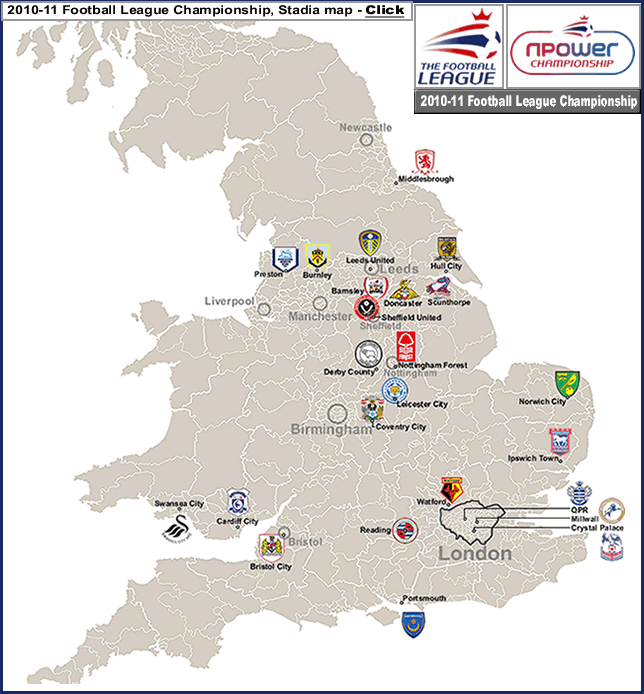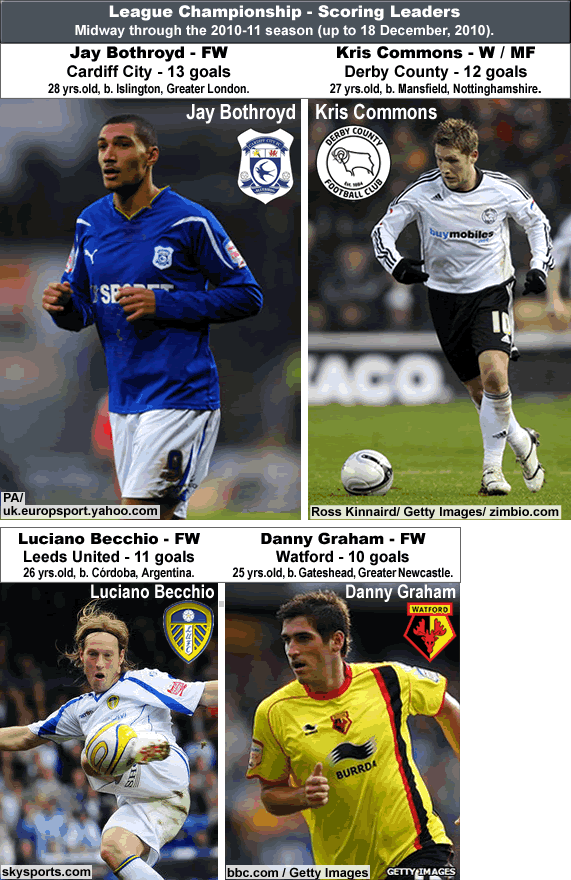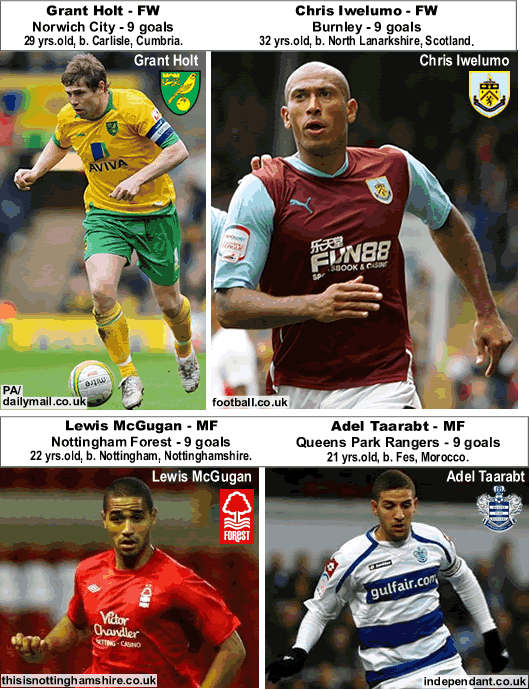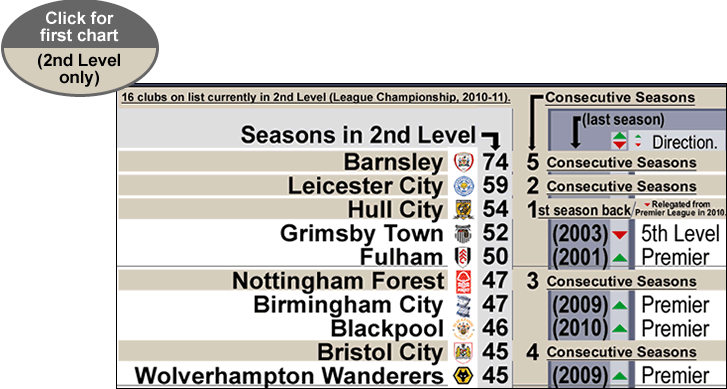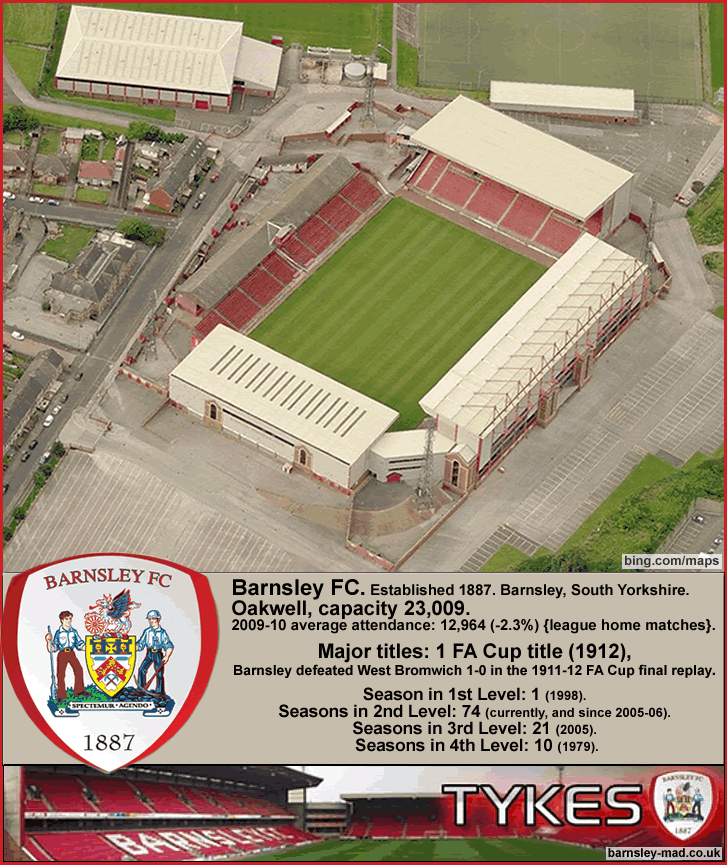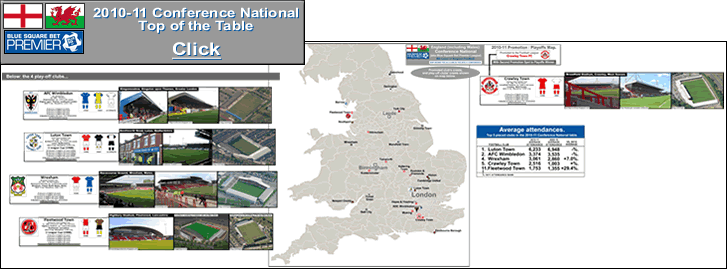
2011 Conference, top of the table
…
Play-off Final – AFC Wimbledon 0-0 Luton Town in AET/Wimbledon 4-3 on penalties/AFC Wimbledon are promoted to the Football League (!!!). On 21 May 2011 at City of Manchester Stadium, Manchester, attendance 18,195.
From Guardian.co.uk, by Sachin Nakrani, ‘AFC Wimbledon beat Luton on penalties to reach the Football League‘.
Play-off results…
[Wrexham 0-3 Luton Town, at the Racecourse Ground, Wrexham, Wales, attendance 7,211]
From Conference National site, ‘Luton Take Commanding First-Leg Lead‘.
[Luton Town 2-1 Wrexhan / Luton Town wins on 5-1 aggregate, at Kenilworth Road, Luton, Bedfordshire, attendance 9,078']
From Guardian.co.uk, by Sachim Nakrani, ‘AFC Wimbledon beat Luton on penalties to reach the Football League‘.
[Fleetwood Town 0-2 AFC Wimbledon, at Highbury Stadium in Fleetwood, Lancashire, attendance 4,112]
From BBC.co.uk, ‘Fleetwood 0-2 AFC Wimbledon‘.
[AFC Wimbledon 6-1 Fleetwood Town / Wimbledon wins on 8-1 aggregate, at Kingsmeadow, Kingston upon Thames, southwest London, attendance 4,538.]
From Bluesqfootball.com, ‘ AFC Wimbledon 6-1 Fleetwood (agg 8-1) ‘.
Leading scorers in 2010-11 Conference National (goals scored in all competitions)…
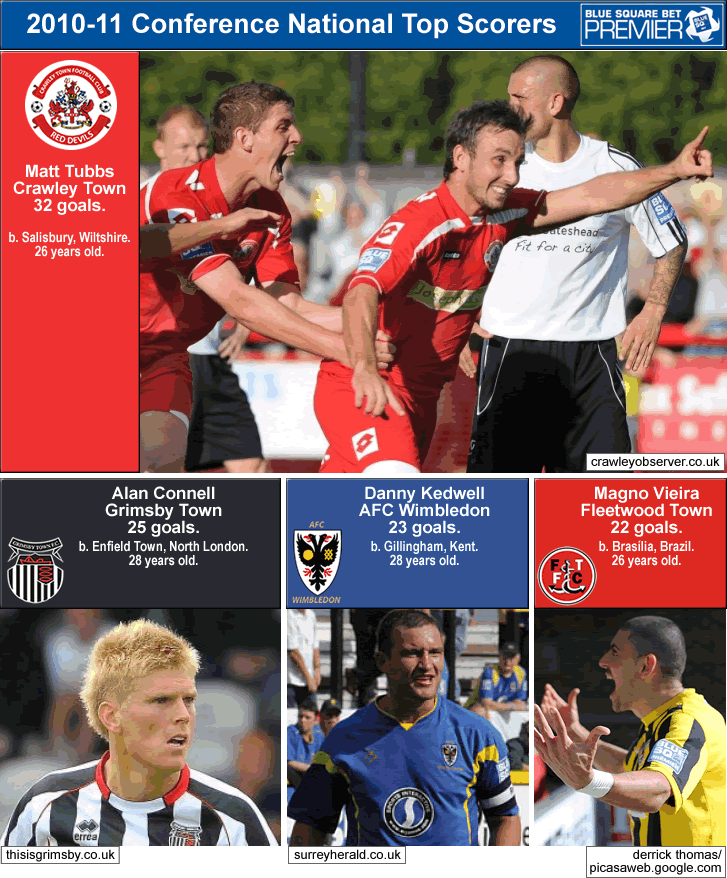
Photo credits – Matt Tubbs – crawleyobserver.co.uk . Alan Connell – thisisgrimsby.co.uk . Danny Kedwell – surreyherald.co.uk – ‘AFC Wimbledon skipper Danny Kedwell taunts big-spending Crawley Town’ . Magno Vieira – Derrick Thomas at picasaweb.google.com, via fleetwoodtownfc.com/Photo Gallery .
…
In the play-offs, second-place AFC Wimbledon’s grassroots-supporters-versus-club-stealing-franchise-operators creation-story and somewhat meteoric rise through the lower reaches of Non-League Football is pretty well known {see this, ‘Wimbledon march onwards and upwards with firm grasp of history – AFC Wimbledon, owned entirely by fans, have risen from adversity to be in touching distance of the Football League‘, from Guardian.co.uk, 4 Sept 2010, by Louise Taylor.}. AFC Wimbledon will face Fleetwood Town, a club who also have been progressing up the football pyramid in an impressive manner. Now Fleetwood Town has a visible monument to this rise…just look, on the map page, at that swank new curved-roof main stand (now called the Parkside Stand) at Fleetwood’s Highbury Stadium in coastal Lancashire.
Fleetwood Town FC are known (brilliantly) as The Cod Army. This incarnation of the club is it’s third, with the first FTFC existing from 1908 to 1976, and FTFC (II) existing from 1977 to 1996. FTFC (III) began in 1997-98 in the North West Counties Football League Division Two, [then a 9th Level league/now a 10th Level League], as Fleetwood Freeport FC (for sponsorship reasons). The club’s first promotion ensued in their second season, in 1999, and in 2002, their name became Fleetwood Town FC (III). Successive promotions in 2005, and then in 2006 saw Fleetwood Town reach the 7th Level in the Northern Premier League Premier Division. Two seasons later, in 2008, Fleetwood Town won automatic promotion to the Conference North by winning the Unibond Norhern Premier League. At this point, the Cod Army already had an impressive fan base for a club at this level, drawing 721 per game in 2007-08 – this in a league that was averaging 313 per game {see these tables from Tony’s Non-League Football site, here}.
Fleetwood Town had a rough go of it initially in the 6th Level in 2008-09, and had to replace their manager with Burnley youth team manager (and former Blackpool and Tranmere midfielder) Micky Mellon. By January, 2010, Mellon became the first full-time manager at Fleetwood, and began introducing a number of new signings that upped the talent quotient in this corner of Lancashire. That season included Fleetwood Town’s first-ever appearance in the FA Cup Second Round Proper, with a then-record-crowd of 3,280 at Highbury Stadium seeing them fall to League One’s Harlepool United by a score of 2-3. Fleetwood Town’s fan base had grown to the point where the club was averaging 920 per game in league matches, and further progress on the pitch was shown by their 8th place finish in their first season in Conference North.
As a pre-season favorite for promotion in 2009-10, Fleetwood Town established themselves as one of the two strongest teams in the league, with the other being their very nearby rivals, Southport FC (who are 28 km./17 miles down the road in Merseyside). Because of the demise of Leeds-based Farsley Celtic during the 2009-10 Conference North season, that club’s matches were expunged, and this led to Fleetwood Town losing 3 points and missing out on automatic promotion, with Southport instead winning the league title [Southport are now back down, having been relegated, by goal difference, out of the Conference National on Saturday, 30 April, 2011]. Fleetwood won promotion via the play-offs, though, winning it over Alfreton Town at Highbury Stadium last May in front of 3,592 (the current record crowd there).
Chairman Andy Pilley announced that the club would go full-time for 2010-11. The club’s best acquisition after their squad went full-time was Brazilian-born striker Magno Vieira, whom Fleetwood Town purchased from then-relegated Ebbsfleet United. [Vieira went on to score 22 goals for Fleetwood Town this season, which was fourth-best in the league.] By September, Fleetwood Town were in 3rd place. Captain George Milligan, out the door after the full-time policy began, returned in November, 2010. But a string of poor results led them to drop to the edge of the play-off places by the new year. However, Fleetwood Town caught fire near the close of the season and finished with 7 wins in their last 8 matches, and with the late season stumbling of Darlington. York City, and Kidderminster, Fleetwood ended up in the final play-off spot. Fleetwood Town ended up with a 1,753 per game average attendance, up 29 percent from last season.
…
The other play-off match-up features two clubs both with over three-quarters of a Century of League history, but each with recent financial melt-downs… Bedfordshire’s Luton Town FC and Wrexham FC, of North Wales. Of the two, Luton Town have the bigger fan base – biggest in all of Non-League, currently, having drawn above 6,000 per game in both seasons the club has spent outside the League since their near-extinction, administration, and 30-point deduction in 2008-09. Luton Town, known as the Hatters, are the second club in the modern era to have First Division history (with 16 seasons in the English top flight, last in 1991-92) and then subsequent Non-League status [the other one was Oxford United]. Wrexham’s League history only goes up to the 2nd Level (with 4 seasons there, between 1978 and 1982), but the Red Dragons, North Wales biggest club, have 100 seasons of League history, versus 84 seasons accumulated by Luton Town. Wrexham drew 3,061 per game this season (up 7 percent), and are probably hurt by the fact that their Racecourse Ground (capacity 15,500) is too large for their current fan base. Luton Town actually have the exact opposite problem… because of how built-up the area is around their ground, Kenilworth Road (Luton being part of the heavily-populated commuter belt north of London), the club cannot expand or realistically renovate there. This has been a problem at Luton Town for decades. This is how cramped Kenilworth Road is…one of the ground’s entrances is through a portal under a block of flats! That is the Oak Stand entrance, and you can see that entrance-way in one of the three photos for Luton Town on the map page.
Meanwhile, Luton Town look to be of the woods, financial-crisis-wise, but it looks like Wrexham’s problems have only begun. So much so that there was talk for a while that the Conference top brass would not even allow Wrexham to compete in the play-offs, but they will.
…
Crawley Town FC spent 500,000 pounds on a now-successful bid for promotion to the Football League. This was more than all 23 other Conference National clubs, combined, spent on new signings this season. This was in fact more than all 24 League Two clubs, combined, spent on new signings. Their manager, Steve Evans, is a manners-challenged convicted felon who got his previous for cooking the books at Boston United a decade ago {see this, ‘Shamed manager keeps his job‘ (bbc.co.uk/Lincolnshire, 4 Nov. 2006).
As noted in the following article from TwoFootedTackle.com…’There’s a genuine feeling within the lower levels of the game that Evans’ criminal record should have resulted in a lifetime ban.’ {see this article from Jan.30 2011, ‘Why many neutrals won’t be cheering on Crawley in the FA Cup’}.
From When Saturday Comes site, ‘Creepy Crawley buying their way out of the Conference‘ (WSC.co.uk, 13 Jan. 2011, by Matt Ramsay).
…
Photo credits for map page -
Crawley Town/Broadfield Stadium…Broadfield Stadium interior photo with railing in foreground from WorldGroundHop.blogspot.com, here. Main Stand photo by Peer Pawelczyk at EuroPlan-online.de, here, via Soccerway.com,, here. Aerial image from Bing.com/maps/Bird’s Eye satellite view, here.
AFC Wimbledon/Kingsmeadow…Tempest Stand at Kingmeadow photo from DoingThe106.com, here, via ConferenceGrounds.co.uk, here. Main Stand from 100groundsclub.blogspot.com, here. Aerial image from Bing.com/maps/Bird’s Eye satellite view, here.
Luton Town/Kenilworth Road…Oak Stand entrance (between row houses) from SoccerWord.com. Kenilworth Road interior photo from Stadiums.Football.co.uk, here. Aerial image of Kenilworth Road from Bing.com/maps/Bird’s Eye satellite view, here.
Wrexham/Racecourse Ground… Interior photo from WikiStadiums.org, here. Photo of Mold Road Stand with The Kop (terrace) in foreground from Soccerway.com, here. Aerial image of Racecourse Ground from Bing.com/maps/Bird’s Eye satellite view, here.
Fleetwood Town/Highbury Stadium…New stand [construction on parts of the is stadium still ongoing] photo from Flower Design Events sire, here. Architect’s rendering of Highbury Stadium with new Main Stand from FWP Group.co.uk, here. Aerial image from Bing.com/maps/Bird’s Eye satellite view, here.
Thanks to the contributors to the pages at en.wikipedia.org, ‘Conference National‘.
Thanks to Soccerway.com, for attendance figures.
Thanks to the BBC London Non-League Football show.
